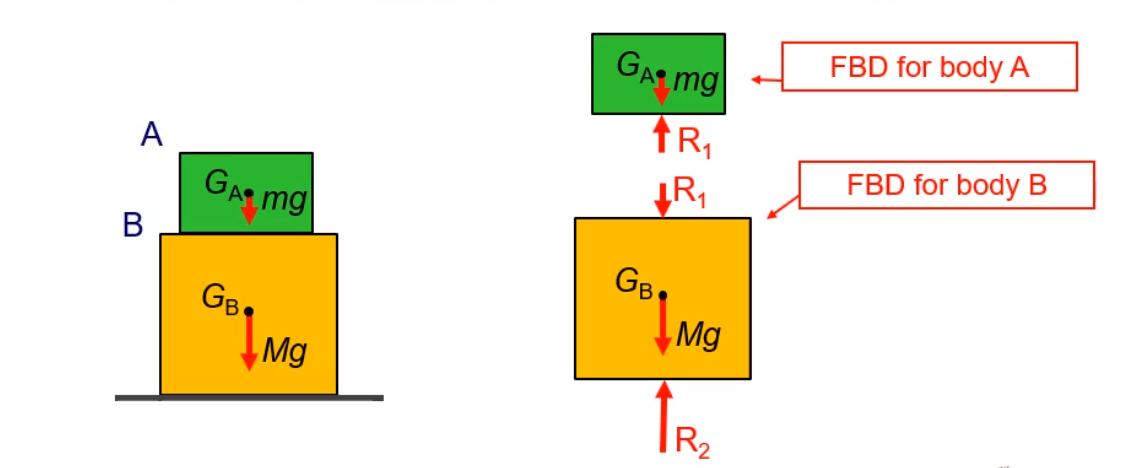4.0 KiB
Executable File
| author | date | tags | title | ||||||
|---|---|---|---|---|---|---|---|---|---|
| Alvie Rahman | \today |
|
MMME1028 // Statics and Dynamics |
Lecture L1.1, L1.2
Lecture L1.1 Exercises
Can be found here.
Lecture L1.2 Exercises
Can be found here here
Newton's Laws
-
Remains at constant velocity unless acted on by external force
-
Sum of forces on body is equal to mass of body multiplied by acceleration
1st Law is a special case of 2nd
-
When one body exerts a force on another, 2nd body exerts force simultaneously of equal magnitude and opposite direction
Equilibrium
- Body is in equilibrium if sum of all forces and moments acting on body are 0
Example
Determine force F and x so that the body is in equilibrium.
-
Check horizontal equilibrium
\sum{F_x} = 0 -
Check vertical equilibrium
\sum{F_y} = 8 - 8 + F = 0F = 2 -
Take moments about any point
\sum{M(A)} = 8\times{}2 - F(2+x) = 0F(2+x) = 16)x = 6
Free Body Diagrams
A free body diagram is a diagram of a single (free) body which shows all the external forces acting on the body.
Where there are several bodies or subcomponents interacting as a complex system, each body is drawn separately:
Friction
- Arises between rough surfaces and always acts at right angles to the
normal reaction force (
R) in the direction to resist motion. - The maximum value of friction
FisF_{max} = \mu{}R, where\mu{}is the friction coefficient F_{max}is also known as the point of slip
Reactions at Supports
There are three kinds of supports frequently encountered in engineering problems:
Principle of Force Transmissibility
A force can be move dalong line of action without affecting equilibrium of the body which it acts on:
This principle can be useful in determining moments.
Two-Force Bodies
-
If a body has only 2 forces, then the forces must be collinear, equal, and opposite:
The forces must be collinear so a moment is not created
Three-Force Bodies
-
If a body in equilibrium has only three forces acting on it, then the lines of actions must go through one point:
This is also to not create a moment
-
The forces must form a closed triangle (
\sum{F} = 0)
Naming Conventions
| Term | Meaning |
|---|---|
| light | no mass |
| heavy | body has mass |
| smooth | there is no friction |
| rough | contact has friction |
| at the point of slip | one tangential reaction is F_{max} |
| roller | a support only creating normal reaction |
| rigid pin | a support only providing normal and tangential reactions |
| built-in | a support proviting two reaction components and a moment |
Tips to Solve (Difficult) Problems
- Make good quality clear and big sketches
- Label all forces, dimensions, relevant points
- Explain and show your thought process---write complete equations
- Follow standard conventions in equations and sketches
- Solve everything symbolically (algebraicly) until the end
- Check your answers make sense
- Don't forget the units





